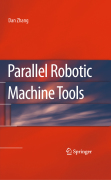
Research and development of various parallel mechanism applications in engineering are now being performed more and more actively in every industrial field. Parallel robot based machine tools development is considered a key technology of robot applications in manufacturing industries. The material covered heredescribes the basic theory, approaches, and algorithms in the field of parallel robot based machine tools. In addition families of new alternative mechanical architectures which can be used for machine tools with parallel architecture are introduced. Given equal importance is the design of mechanism systems such as kinematic analysis, stiffness analysis, kinetostatic modeling, and optimization. Covers the latest material in parallel kinematic machine tools and the junction of parallel robot and machine tools Includes novel conceptions and approaches such as the general kinetostatic model, artificial intelligence based performance optimization, and the global stiffness model Provides large numbers of case study and numerical analysis that will help the reader understandand apply the material presented INDICE: Introduction.- Fundamentals of spatial kinematic mechanisms.- Mathematical background.- Architectures of parallel kinematics machine.- Kineostatic for simple planar parallel mechanisms.- Kineostatic for complex spatial parallel mechanisms.- Reconfigurable parallel kinematic machine tools.- Performance studies.- Simulations.- Optimization.
- ISBN: 978-1-4419-1116-2
- Editorial: Springer
- Encuadernacion: Cartoné
- Páginas: 380
- Fecha Publicación: 01/12/2009
- Nº Volúmenes: 1
- Idioma: Inglés
